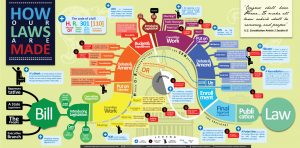This graphic describes the process needed to enact a legislative proposal into law. The legislative process can be quite complicated and will require people across the nation to align and push the legislative proposal through in a manner that does not allow it to be watered down. In the immediate future, ONUS will include a taped narrative describing the legislative process depicted in this diagram. This companion document by John Sullivan describing how law are made provides a thorough description of the legislative process depicted in the diagram above, i.e., the process URLEIA must travel in order to becomes law.
What Happens to URLEIA Once it Becomes Law?
The newly enacted legislation will be sent to the Office of the Law Revision Counsel. The office is charged with consolidating and codify laws passed by Congress without making any substantive changes to the law and to prepare the revised code for enactment into “positive law.”
Currently, U.S. statutory law is organized into 50 books, known as titles. Each title should contain only those laws that have to do with the subject area reserved for the title, for example, Title 7 should only contain laws having to do with agriculture. Additionally, each title should only contain general and permanent laws. Thus, it should not contain any law that has an expiration date such as an annual appropriate law or a law that does not apply to the general public such as a private law, which is a law written for a specific person.
The last time law were organized (codified) was in 1926. Since then, laws have been placed into codes wherever convenient an the Office of the Law Revision Counsel is currently working to reorganize laws, which includes correcting technical errors, removing laws that are obselete and rewording laws where needed. The offices’s recodifications do not have full legal effect until they are enacted into law by congress. It is at that point that the laws become known as “positive law.”
People engaged in the URLEIA legislative process will remain involved to ensure that the codifications made by the Office of the Law Revision Counsel are in keeping with the purposes and intent of URLEIA as enacted.
